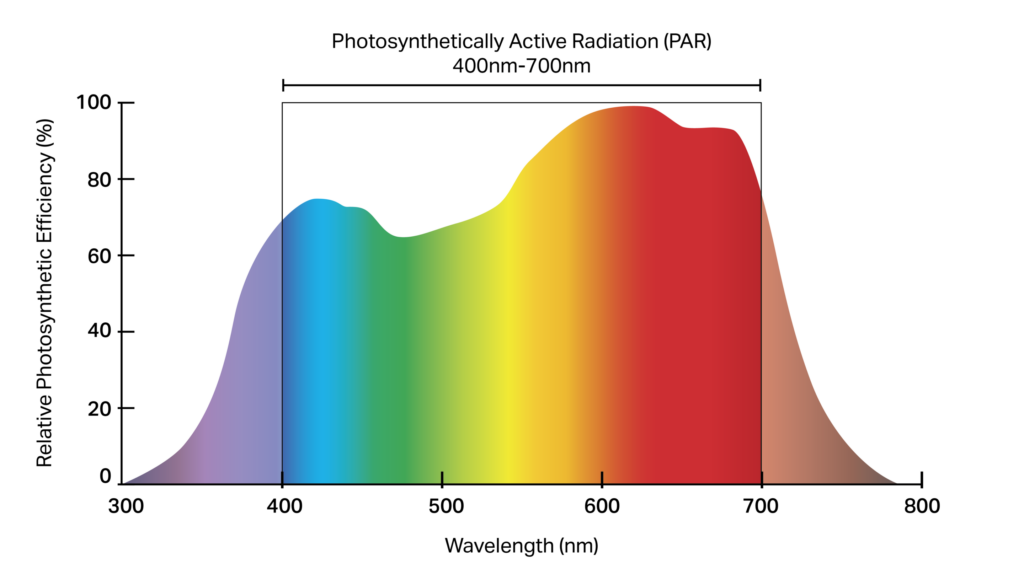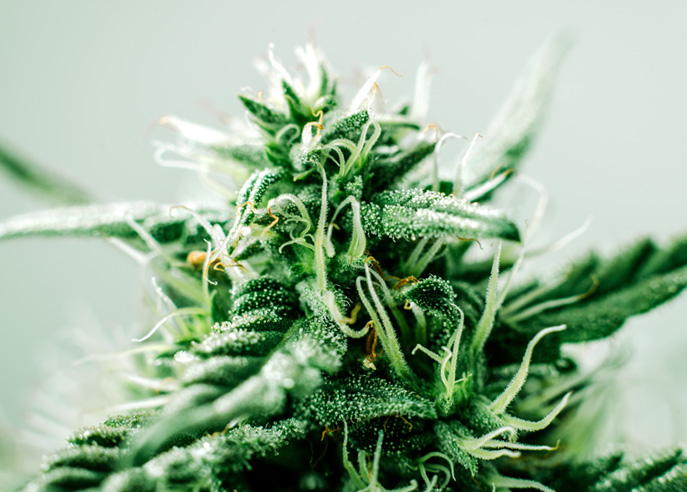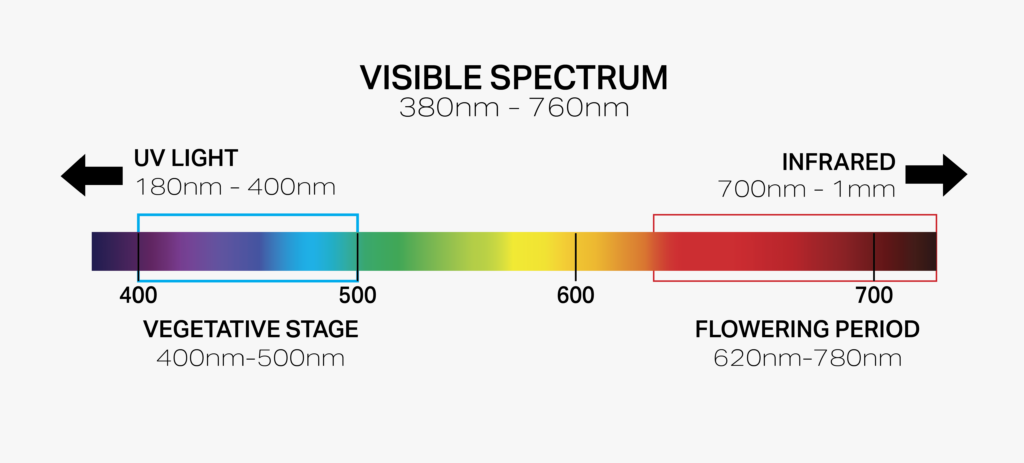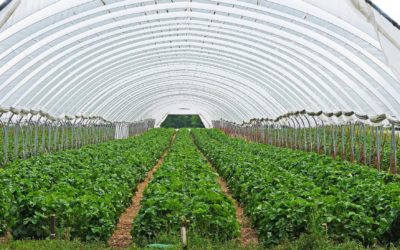The use of LED grow lights in crop farming has recently seen substantial growth. However, choosing the right light spectrum for plants and knowing how they affect photosynthesis, can be challenging and oftentimes confusing.
See all available Cannabis Grow Lights by BIOS
This article aims to help you understand the light spectrums needed for plant growth and how full spectrum LED lighting is now widely used for crop production. We’ll address what broad-spectrum lighting is, how different grow light spectrums affect different stages of plant growth, and its effect on Cannabis production.
What is Grow Light Spectrum?
Grow light spectrum refers to the electromagnetic wavelengths of light produced by a light source to promote plant growth. For photosynthesis, plants use light in the PAR (photosynthetic active radiation) region of wavelengths (400nm-700nm) measured in nanometers (nm).
Nanometers are a universal unit of measurement but also used to measure spectrum of light – humans can only detect visible light spectrum wavelengths (380-740nm). Plants, on the other hand, detect wavelengths including our visible light and beyond, to include UV and Far Red spectrums.
It’s important to note light spectrums affect plant growth differently depending on things like environmental conditions, crop species, etc. Typically, chlorophyll, the molecule in plants responsible for converting light energy into chemical energy, absorbs most light in blue and red light spectrums for photosynthesis. Both red and blue light are found in the peaks of the PAR range.
LED Grow Lights
LED grow lights are energy-efficient lights used by indoor and greenhouse farmers and Cannabis growers too. Used as either a sole light source (indoor) or supplementary (greenhouses), LEDs help plants grow using full-spectrum lighting at a lower cost than traditional HPS lamps (1).
Many growers take advantage of LED lights to help scale plant production due to their full light spectrum capabilities, low heat waste and maintenance, and extended lifespan. And given a plant’s physiology and morphology are strongly affected by specific spectrums, LED grow lights can efficiently promote growth in crops (2) at specific times in the growth cycle. With the ability to closely monitor quality, energy output can be easily evaluated for scaling crop production.
Grow Light Spectrum Chart

The above chart shows the PAR range – the spectrum of light plants use for photosynthesis. Grow light spectrum charts like this include both the PAR range and other spectrums as it’s been discovered that wavelengths outside of the PAR range are also helpful for plant growth.
The peak of photosynthetic efficiency (light absorption) falls in the red light and blue light spectrums of the PAR range. Red radiation (around 700nm) is considered most efficient at driving photosynthesis – especially in the flowering stage for biomass growth (important to Cannabis growers). Blue light is essential for both the vegetative and flowering stages of plant growth, but mainly for establishing vegetative and structural growth.
What is the Ideal Grow Light Spectrum for Plants?
The ideal grow light spectrum for plants depends on several factors. These include how specific plants use PAR-spectrum light for photosynthesis but also the wavelengths outside of the 400-700nm range. This light can help accelerate flowering, increase nutrition, speed up rate of growth, etc. If the light source is sole (indoors) or supplementary (greenhouses) also affects which grow light spectrums should be used.
Generally, photosynthetic efficiency occurs at the red and blue peaks which means plants absorb these spectrums most when growing. You might think the ideal grow light spectrum is equal to sunlight – after all, it’s had millions of years of experience – however, it’s more detailed than this.
Sunlight produces a lot of greens, yellows, and oranges – they’re the most readily available spectrums of light. In fact, studies (3) tell us how green light, while not absorbed by chlorophyll as well as red and blue (hence why most plants appear green), it’s absolutely critical for photosynthesis.
Light spectrums outside of blue and red wavelengths are used least by plants to grow as reds and blues are where most photosynthetic activity occurs – a big reason why full-spectrum grow lights are incredibly efficient because a grower can get very specific.
Engineered for unmatched reliability
Request a free light plan built to your facility specs and your plants' requirements.
What is Broad Spectrum Lighting?
Broad spectrum lighting – often referred to as full spectrum lighting, means the complete spectrum of light given by sunlight. This means wavelengths of broad spectrum lighting include the 380nm-740nm range (which we see as color) plus invisible wavelengths too, like infrared and ultraviolet.
One advantage of LED grow lights is they can be set up to produce certain wavelengths for specified periods during the day or night. This makes it ideal for plants because growers can isolate specific spectrum colors depending on crops and growing conditions. Full spectrum lighting can also speed up or slow growth rate, enhance root development, improve nutrition and color etc.
Grow Light Spectrum and Cannabis

The grow light spectrum for Cannabis varies when compared to other plants as growers are focused on maximizing yields, controlling levels of THC and other cannabinoid production, increasing flowering, and to maintain overall uniformity.
Aside from visible colors, Cannabis responds especially well to wavelengths just outside of the PAR range. Therefore, an added benefit of using full spectrum LEDs is the ability to use specific doses of ultra-violet wavelengths (100-400nm), and far-red wavelengths (700-850nm) outside of the PAR range.
For example, an increase in far-red (750nm-780nm) can help stimulate Cannabis stem growth and flowering – something growers want, whereas necessary blue light in minimal amounts, can prevent uneven elongation of stems and leaf shrinkage.
So, what’s the ideal grow light spectrum for Cannabis? There’s no single spectrum since varying light exposure promotes certain plant morphology during different stages of growth. The chart below explains the concept of outer-edge PAR light spectrum use.

Personal vs. Commercial Cannabis
The difference with personal vs commercial grow lights for Cannabis can be determined by a number of factors. Firstly, the available light spectrums in commercial LED grow lights will include the full PAR range and beyond – which is particularly advantageous for Cannabis growers.
Commercial grow lights can be wirelessly configured to put out specific wavelengths and intensities at certain intervals in a 24-hour cycle – grow light settings often work in conjunction with a grower’s HVAC systems too.
With personal LED grow lights, lumens per watt will likely be lower – which makes them less energy efficient with smaller potential yields. Many are not broad spectrum and may only offer small spectrums of blue and red light. Additionally, while personal grow lights will still be inexpensive to run, other factors to be considered include noisier fans, inferior quality plastic casing, shorter LED lifespans and overheating issues.
Should I Use a Different Light Spectrum for Different Plants?

In some crops, blue light can benefit nutritional levels and coloring, and a higher red to far-red ratio can help with leaf size and flowering. It’s why today’s full-spectrum LEDs are so advanced – because by selecting the right quantities of red and blue light (4), chlorophyll pigments absorb more light they need.
Cannabis growers – who pay attention to UVB/blue for its various structural and THC-potency benefits, which we’ll get into, are predominantly concerned with leaf size and flowering. Therefore, far-red and red light is relatively more important to boost their yields.
Other indoor growers are also experimenting with the controlled use of far-red spectrum, like salad leaf farmers for example. Plants associate this spectrum with shading from direct sunlight, which would happen lower down the canopy, causing leaf & stem stretching as the plant reaches out for sunlight.
This means when used strategically, bigger leaves and flowering can occur without unnecessary stress. So while there is no specific LED grow light spectrum for any particular plant, the ratio of red to blue light is very important to maximize growth and the rate of photosynthesis.
Spectrum for Photosynthesis, Growth, and Yield
For photosynthesis to occur and chlorophyll to absorb the maximum amount of light for plant growth, plants use both blue and red light most efficiently. Other spectrums of light, like greens/yellows/oranges, are less useful for photosynthesis due to the amount of chlorophyll b, absorbed largely from blue light, and chlorophyll a, absorbed largely from red and blue light.
It’s worth noting photosynthesis is more complex than just chlorophyll absorption, but it’s important to recognize the fundamental principles.
For growth, blue light is essential to help plants produce healthy stems, increased density, and established roots – all which occur in the early vegetative growth stages. Growth then continues with increased red light absorption, resulting in longer stems, increased leaf and fruit/flowering etc. It’s here that red light plays the dominating role in plant maturity and, therefore, size.
And finally, yield – this comes down to a combination of light spectrums and is often very unique to growers, including growers of several varieties of the same crop (like Cannabis). There’s no one single light spectrum that produces more of a crop – optimal lighting is very much a holistic, ever-changing process.
Grow Light Spectrum by Type
Certain light spectrums trigger growth characteristics in plants. In general, blue light spectrums encourage vegetative and structural growth and red light promotes flowering, fruit, leaf growth, and stem elongation. Each crop type is sensitive to different spectrums and quantities of light at different times throughout a daylight cycle – this directly affects the rate of photosynthesis.
Essentially, we know that controlling grow light spectrum can have a significant impact on areas of growth – like flowering, flavor, color, compactness etc. However, it’s important to recognize that signaling specific growth factors is part of a much larger, complex cycle. Results also vary depending on the environment (indoor or greenhouse), the relative temperature/humidity, crop species, light intensity (lumens per watt), and photoperiod etc.
Let’s look at specific grow light spectrums and their application in horticulture.
UV Light Spectrum (100–400 nm)
UV light spectrum, which is not visible to the human eye, is outside the PAR range (100nm-400nm). Around 10% of the sun’s light is ultraviolet, and like humans, plants can be harmed from overexposure to UV light. Categorized into 3 types, UV-A (315-400 nm), UV-B (280-315 nm), and UV-C (100-280 nm).
While the benefits of ultraviolet light use in horticulture are still being researched, UV light is often associated with darker, purple coloring – in fact, small amounts can have beneficial effects on color, nutritional value, taste, and aroma.
Research shows environmental stress, fungus, and pests can also be reduced using controlled amounts of UV. Research has emerged that suggests an increase in cannabinoids like THC (5) in Cannabis can be achieved using UV-B light (280nm – 315nm).
Blue Light Spectrum (400–500 nm)
Blue light spectrum is widely responsible for increasing plant quality – especially in leafy crops. It promotes the stomatal opening – which allows more CO2 to enter the leaves. Blue light drives peak chlorophyll pigment absorption which is needed for photosynthesis.
It’s essential for seedlings and young plants during vegetative stages as they establish a healthy root and stem structure – and especially important when stem stretching must be reduced.
Green Light Spectrum (500–600 nm)
Green wavelengths have been somewhat written off as less important for plant photosynthesis given it’s (in)ability to readily absorb chlorophyll compared to red or blue light spectrums. Nonetheless, green is still absorbed and used for photosynthesis; in fact, only 5-10% is actually reflected – the rest is absorbed or transmitted lower down! This is due to green light’s ability to penetrate a plant’s canopy
In greenhouses, due to the presence of sunlight, supplementing green light spectrum using LED grow lights would be less important compared to crops are grown solely indoors – like Cannabis or vertical crop farming.
Red Light Spectrum (600–700 nm)
Red light is known to be the most effective light spectrum to encourage photosynthesis as it’s highly absorbed by chlorophyll pigments. In other words, it sits in the peaks in chlorophyll absorption. Red light wavelengths (particularly around 660nm) encourage stem, leaf, and general vegetative growth – but most commonly, tall, stretching of leaves and flowers.
A balanced pairing with blue light is necessary to counteract any overstretching, like disfigured stem elongation. It’s important to consider that while red is the most responsive light spectrum for plants, its efficacy really steps in when in combination with other PAR wavelengths.
Far-red Light Spectrum (700–850 nm)
There are a few ways far-red can affect plant growth – one is to initiate a shade-avoidance response. At around 660nm (deep red) a plant senses bright sunlight exposure. From 730nm and beyond – i.e. a higher ratio of far-red to red light, a plant will detect light “shade” from another plant or leaves higher up the canopy, so stretching of stems and leaves occurs.
Far-red can be very useful to promote flowering, and in certain plants, increase fruit yield (6). In short-day plants like Cannabis, which rely on longer periods of darkness, 730nm can be used at the end of a light cycle to promote flowering. Many growers are experimenting with interrupting the dark cycle with bursts of red light to boost growth and flowering.
Finding the Right Grow Light
There’s a great deal of information and science to take on board as we understand the way plants interact with different light spectrums. Optimizing yield production and consistent quality of plants we’ve learned are attributed to light spectrums used together – much like natural sunlight.
At BIOS we’re constantly developing our knowledge and research of how light spectrums on specific crops and strains work best – and at which time during a plant’s light cycle. Our LED grow lighting systems are designed and developed using detailed scientific research to give growers the control of using the ideal light spectrum for optimizing the yield, quality, and variability of their plants.

The industry’s most reliable grow lighting.
Backed by the Industry's only 7 year warranty
References
(1) Nelson, Jacob & Bugbee, Bruce. (2014). Economic Analysis of Greenhouse Lighting: Light Emitting Diodes vs. High Intensity Discharge Fixtures. PloS one. 9. e99010. 10.1371/journal.pone.0099010.
Available: <https://www.researchgate.net/publication/262927860_Economic_Analysis_of_Greenhouse_Lighting_Light_Emitting_Diodes_vs_High_Intensity_Discharge_Fixtures>
(2) Darko, E., Heydarizadeh, P., Schoefs, B., & Sabzalian, M. R. (2014). Photosynthesis under artificial light: the shift in primary and secondary metabolism. Philosophical transactions of the Royal Society of London. Series B, Biological sciences, 369(1640), 20130243.
Available: <https://www.ncbi.nlm.nih.gov/pmc/articles/PMC3949401/>
(3) Hayley L. Smith, Lorna McAusland, Erik H. Murchie . (2017). Don’t ignore the green light: exploring diverse roles in plant processes, Journal of Experimental Botany, Volume 68, Issue 9, 1 April 2017, Pages 2099–2110,
Available: <https://doi.org/10.1093/jxb/erx098>
(4) Naznin, M.T., Lefsrud, M., Gravel, V. and Azad, M.O.K. (2019). “Blue Light added with Red LEDs Enhance Growth Characteristics, Pigments Content, and Antioxidant Capacity in Lettuce, Spinach, Kale, Basil, and Sweet Pepper in a Controlled Environment.” Plants(Basel), 8(4). Available:<https://www.ncbi.nlm.nih.gov/pmc/articles/PMC6524371/>
(5) Magagnini G, Grassi G, Kotiranta S. (2018), The Effect of Light Spectrum on the Morphology and Cannabinoid Content of Cannabis sativa L, Med Cannabis Cannabinoids, 1:19-27. Available:<https://doi.org/10.1159/000489030>
(6) Kalaitzoglou, P., van Ieperen, W., Harbinson, J., van der Meer, M., Martinakos, S., Weerheim, K., Nicole, C., & Marcelis, L. (2019). Effects of Continuous or End-of-Day Far-Red Light on Tomato Plant Growth, Morphology, Light Absorption, and Fruit Production. Frontiers in plant science, 10, 322. https://doi.org/10.3389/fpls.2019.00322.
Available: <https://www.ncbi.nlm.nih.gov/pmc/articles/PMC6448094/>



